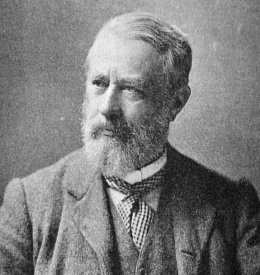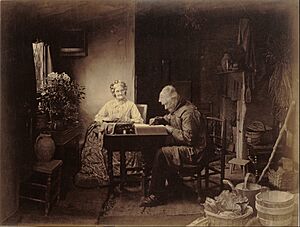Henry Peach Robinson facts for kids
Henry Peach Robinson (born July 9, 1830, in Ludlow, Shropshire, England – died February 21, 1901, in Royal Tunbridge Wells, Kent, England) was an English photographer. He is famous for being one of the first to use a technique called combination printing. This means he would join several different photo negatives or prints together to create one single image. It was an early form of what we now call photomontage. He also strongly believed that photography should be seen as a true art form.
Life of a Photography Pioneer
Henry Peach Robinson was the oldest of four children. His father, John Robinson, was a schoolmaster. Henry went to school in Ludlow until he was 13. After that, he studied drawing for a year. Then, he became an apprentice to a bookseller and printer.
He continued to study art while working in bookselling. In 1852, he even showed an oil painting at the Royal Academy. In the same year, he started taking photographs. Five years later, he met another photographer named Hugh Welch Diamond. This meeting inspired Henry to focus completely on photography. In 1855, he opened his own photo studio in Leamington Spa, where he took portraits.
In 1856, he helped start the Birmingham Photographic Society. He was one of its first members.
In 1859, Henry married Selina Grieves. His son, Ralph Winwood Robinson, also became a photographer.
By 1864, when he was 34, Henry had to close his studio. He became ill from being around the strong chemicals used in photography back then. After this, he found it easier to create his combination prints by cutting and pasting different photos together. This was less risky than working with chemicals in the darkroom.
Henry moved to London but stayed very involved in the ideas behind photography. In 1868, he wrote an important book called Pictorial Effect in Photography. This book gave tips on how to make photos look like paintings. Around this time, his health got better. He opened a new studio in Tunbridge Wells. In 1870, he became a leader in the Royal Photographic Society. He kept fighting for photography to be seen as an art.
His business partnership ended in 1875. Henry continued the studio until he retired in 1888. His son, Ralph, then took over the business. Henry was also a member of another photography group called the Brotherhood of the Linked Ring. He was active there until 1897.
Henry Peach Robinson died in 1901 at the age of 70. He is remembered as a key figure in making photography an accepted art form.
Famous Photographic Works
Henry Peach Robinson was one of the most important art photographers of his time. His third and most famous picture was "Fading Away" (1858). This photo was very popular, even though it showed a sad scene of a young girl who was sick.
He was inspired by artists like the Pre-Raphaelites and John Ruskin. He also liked the paintings of J. M. W. Turner. Henry strongly believed that making combination photographs was just as difficult and artistic as painting a picture. He compared his work to an ancient Greek story where an artist combined the best features of five different women to create a perfect painting. This showed how much he thought photography could be a high form of art.
Where to See His Art
Henry Peach Robinson's photographs are kept in many museums around the world. Some of these include:
- The Herbert F. Johnson Museum of Art
- The Clark Art Institute
- The Seattle Art Museum
- The Saint Louis Art Museum
- The George Eastman Museum
- The Worcester Art Museum
- The SFMOMA
- The University of Michigan Museum of Art
- The LACMA
- The Harvard Art Museums
- The Princeton University Art Museum
- The Metropolitan Museum of Art
- The J. Paul Getty Museum
- The National Gallery of Victoria




